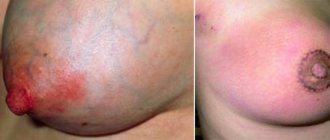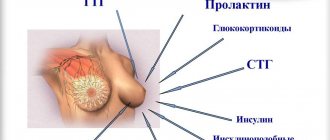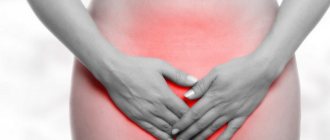It won't be easy to miss green discharge from your breasts. They stain the laundry, are clearly visible and are often accompanied by other unpleasant symptoms, making the patient suspect that she has the most serious problems. Pus from the chest is a sign of a pathological process that requires immediate diagnosis and qualified medical care. Delaying a visit to the clinic and trying to self-medicate can have the most dire consequences, including the loss of one or two glands. Therefore, if you detect even slight discharge of a greenish tint, you should postpone everything and consult a doctor.
What does the color of discharge mean?
For a mammologist, the determining factors are the consistency and color of the secretion. It is from these characteristics that he can make assumptions about the pathology that caused the discharge:
- Transparent and odorless before menstruation is a normal natural phenomenon.
- White - if this is not caused by pregnancy, indicates a tumor of the pituitary gland, which develops against the background of long-term use of contraceptives.
- Yellow (if the woman is not pregnant), which are accompanied by pain, may be a sign of mastopathy.
- Green ones contain pus; usually in such cases, a woman is diagnosed with mastitis.
- Bloody - indicate destruction of blood vessels and can be a symptom of cancer.
- Dark ones always indicate the formation of cysts and tumors.
Treatment of a pathological symptom
You can get rid of green discharge from the mammary glands only under one condition - to completely recover from the disease of which they are a sign.
There is no single therapeutic regimen for the treatment of nipple discharge, as it can be a symptom of many diseases, including serious ones. Therefore, treatment is prescribed only after a thorough examination of the body and establishment of a specific diagnosis.
Based on the diagnostic results, the doctor develops an individual therapeutic approach:
- Medication.
- Puncture (pumping out secretions).
- Operational.
For different diseases, individual treatment methods are used, taking into account the degree of neglect of the pathology, the general well-being of the patient and other important clinical aspects.
| State | Treatment methods |
| Ectasia | Antibacterial or anti-inflammatory therapy is carried out, or the damaged canal is excised. |
| Purulent discharge | It is recommended to take antibiotics or surgically open the abscess. |
| Mastitis | Treatment can be conservative or surgical, depending on the severity of the disease. |
| Intraductal papilloma | Only surgical intervention is indicated, in which the affected tissue is excised and histologically examined to exclude malignancy. |
| Paget's disease | A mastectomy is performed (removal of both mammary glands); in very rare cases, only one tumor may be removed. |
In addition, the features of treatment also depend on what factors provoked the underlying disease:
- Vitamin deficiency - vitamin and mineral complexes are prescribed.
- Problems of the thyroid gland - it is necessary to take iodine-containing, enzyme and homeopathic preparations, as well as herbal remedies.
- Hormonal imbalance – a course of hormonal medications is recommended.
Of the possible home remedies, diet therapy and giving up bad habits will provide invaluable help to the body.
Other folk options are permissible only after the final diagnosis has been determined and the doctor’s permission. However, they cannot be used as the main treatment due to their weak effect.
Alternative medicine recipes are suitable as an additional method to drug therapy or as a supportive measure after surgery.
Physiological reasons
The secretion, which does not look like milk and has an unhealthy odor, requires special attention. Physiological reasons include:
- Pregnancy is when the female body prepares to produce milk.
- Weaning the baby from the breast.
- Abortion (miscarriage) often leads to the release of colostrum from the mammary glands.
- Long-term use of hormonal contraceptives that stimulate lactation. The symptom disappears immediately after discontinuation of the drug.
- Frequent use of antidepressants.
- Constantly wearing synthetic shapewear, which squeezes and irritates the nipples.
- Menstruation.
It is important to remember that in a woman who has given birth, the fluid from the nipples always has a white tint. If the woman has not given birth - only transparent.
Discharge from the mammary glands when pressed
From a young age, mothers instill in their daughters a caring attitude towards the mammary glands, because they realize how dangerous the consequences can be in the absence of it. But it is not always possible to predict events and protect the breasts from external influences, which can cause various ailments. Discomfort, pain when touching the chest - all this is not as alarming as discharge from the mammary glands. It is to these manifestations that women react sharply and become overly upset, because they do not fully understand the level of danger. Therefore, it is necessary to understand what such changes may promise and what are the reasons for their occurrence.
Discharge from the mammary glands when pressed
What problems are hidden behind discharge from the mammary glands when pressed? Minor discharge from the nipples, which has no odor and is not accompanied by unpleasant symptoms, does not threaten health in any way, but is only the result of the process of cleansing the mammary glands.
It is inappropriate to take action or worry during pregnancy, as women in this position may experience discharge when pressure is applied, which is normal.
You can determine what the discharge signals by its color and consistency:
- yellow discharge from the breast, accompanied by severe pain: such manifestations most often indicate that the woman is actively developing fibrocystic mastopathy. The cause of this disease may be hormonal imbalance. Mastopathy is also accompanied by inflammatory processes, so during its course a woman may experience excessive breast swelling, regardless of the menstrual cycle, and experience pain;
- discharge of a purulent nature: such manifestations indicate mastitis, its advanced form. Redness, peeling, severe chest pain, green discharge - all this also refers to the symptoms of this disease. Mastitis develops due to infection in the body, and therefore requires special treatment. Young mothers who are breastfeeding are at risk;
- white discharge from the nipples, discharge in the form of colostrum: most often appear at the time of active progression of galactorrhea, a disease the occurrence of which is caused by hormonal imbalance. In addition to discharge, a woman may also experience changes in her menstrual cycle. In some cases, the discharge may have a brownish tint when pressed. As for the reasons for the appearance of hormonal disorders, there may be several of them: long-term use of hormonal contraceptives, exposure to severe stress, alcohol abuse;
- clear discharge from the mammary glands when pressed: in case of trauma to the mammary glands, a woman should be prepared for some manifestations, which include discharge. They can also bother middle-aged women, who quite often experience ductectasia: this is a disease in which the milk ducts dilate, thereby opening the way for the release of secretions;
- yellow-green liquid: appears in women aged 40 to 50 years and indicates ectasia of the mammary glands. This disease must be combated, since it is accompanied by severe inflammatory processes. The treatment method is based on taking anti-inflammatory and antibacterial drugs;
- spotting: primarily caused by a virus. Intraductal papilloma is a disease that requires serious treatment and constant monitoring.
Causes of discharge from the mammary glands when pressure is applied
So, there are many reasons for the appearance of discharge from the mammary glands when pressed, a minority of which do not bode well. Unfortunately, in other cases, the liquid signals problems that require prompt solutions. To cope with the disease, you must first identify it, which is possible if you undergo a special examination. Therefore, having discovered negative violations, you need to act, because it is much easier to fight the disease in the early stages of its occurrence.
As for predisposition, the genetic factor is indeed of great importance. Therefore, young ladies who have had similar problems in their female line need to be more attentive to their health and monitor their hormonal system.
An unsatisfactory psychological state and emotional instability also contribute to the formation of breast problems.
Preventive measures
Women who would like to avoid problems associated with the condition of the glands are concerned about possible precautions. It is indeed possible to prevent the development of breast diseases if you follow the rules of behavior. So, you can avoid the appearance of discharge by:
- wearing high-quality underwear that does not compress the chest and does not cause discomfort: a bra should first of all be comfortable, made from natural fabrics, and only then beautiful. At the same time, many young ladies choose this product based on its appearance;
- regular washing with baby soap;
- consuming the amount of microelements and minerals required by the body: calcium, zinc, iodine, selenium - these are the main substances on which the health of the mammary glands depends;
- refusal to visit the solarium or topless sunbathing;
- maintaining a healthy lifestyle: excessive alcohol consumption and smoking can contribute to the development of diseases;
- refusal of nutritional supplements and creams that enlarge the breasts: such products will not bring the expected result, but can cause harm;
- manifestations of self-love: a bad attitude towards oneself, low self-esteem - all this can lead to the development of mastopathy and, accordingly, the appearance of discharge. Therefore, you should not be overly critical of your shortcomings; it is more advisable to love yourself and open up to the world around you.
Discharge from the mammary glands during pregnancy
In order not to fall into a risk group and not to feel discomfort from the appearance of discharge from the mammary glands when pressing during pregnancy, you must also remember the importance of pregnancy. You should not shift this event to a more favorable moment when building a career or arranging your own home, because timely pregnancy is the key to healthy mammary glands.
Sports and regular intimacy with your partner will also help prevent glandular problems. It is necessary to properly plan your day so that there is always a window for physical activity, since the presence of extra pounds increases the likelihood of encountering a problem. Don’t forget about the importance of nutrition: a woman’s body does not need fast food, fried potatoes and sugary drinks, so you need to carefully adjust your diet. To maintain the health of the mammary glands, you need to regularly eat nuts, broccoli, tomatoes, herbs, citrus fruits, and liver.
Regular visits to a specialist are also included in the list of preventive measures, so it is necessary not to refuse consulting services. In addition, timely identification of the disease always increases the chances of a quick recovery. In addition, a specialist can advise which rules to follow in order to maintain health in a particular case. After all, each young lady has individual characteristics in the structure of the mammary glands and hormonal background. The night work schedule has a detrimental effect on the condition of the glands, so it is advisable for ladies to avoid such activities and devote the night to sleep.
Thus, discharge from the mammary glands when pressed is a fairly common phenomenon that worries many women. Moreover, such a manifestation can promise both danger and be a natural process of cleansing. To recognize the disease or ensure its absence, you just need to correctly use the information provided. A timely visit to a specialist can significantly facilitate the treatment process and also protect against complications. If the risk of developing the disease is scary, then it is worth learning the rules of behavior and instilling respect for the glands. Only in this case can the likelihood of discharge be reduced. Proper nutrition, regular exercise, a healthy intimate life, high-quality underwear, timely pregnancy - all this can help protect against breast diseases.
voproskmame.com
Pathological causes
Hormonal imbalances, inflammation, tumors and pelvic diseases can lead to nipple discharge. Endocrine diseases and abortions often become the main cause of the development of diseases that are accompanied by such a symptom.
To rule out oncology, at the first incomprehensible discharge from the nipples you should go to the doctor. This may be a symptom of pelvic diseases associated with a violation of the internal microflora. These include: candida fungus, dysbiosis, inflammation and tumors in the pelvis.
Breast injuries can also cause inflammation, accompanied by purulent discharge from the nipples.
Treatment methods
Treatment tactics are determined by the doctor after examination.
To completely eliminate discharge with purulent contents from the mammary glands, it is necessary to complete a full course of treatment prescribed after diagnosis of the underlying disease. Otherwise, the appearance of purulent secretion will recur after a short time, and the pathological process may become chronic and cause the development of breast cancer.
The main treatment options for purulent discharge are divided into three groups - conservative, surgical or puncture, which involves pumping out the purulent contents. The age and condition of the patient’s body, the neglect of the pathological process, the presence of other diseases and other clinical reasons are taken into account.
Certain diseases, the symptom of which is the appearance of purulent discharge from the chest, require specific treatment methods:
- For ectasia, antibacterial therapy is carried out or the method of excision of the milk canal with identified pathology is used.
- If there is an inflammatory process with the formation of an abscess, the latter is opened, after which the patient is prescribed a course of anti-inflammatory drugs.
- For mastitis, the patient is prescribed a conservative course of treatment or undergoes surgery.
- In Paget's disease, either part of the breast with the tumor or the entire breast is removed.
For intraductal papilloma, the only treatment option is excision of the affected tissue followed by a biopsy to clarify the nature of the neoplasm.
What diseases are accompanied by discharge?
The presence of certain pathologies can indeed cause the appearance of fluid from the mammary glands. This usually occurs against the background of hormonal imbalance or changes in the activity of the organs of the female reproductive system. Such diseases include:
- Galactorrhea. The main symptom of this pathology is the release of milk (colostrum) in a woman outside of pregnancy or lactation. The direct cause of the development of galactorrhea is a serious hormonal imbalance in the female body, which helps stimulate the level of the hormone prolactin.
- Injury to the mammary glands and milk ducts changes their normal state and often leads to the formation of fluid (sometimes bloody).
- Mastopathy is a change in the ratio of glandular and connective tissue or their proliferation. This is the most common pathology of the mammary glands not associated with pregnancy. Accompanied by the development of compactions, cysts, pain and clear or greenish discharge. Typically, mastopathy occurs against the background of hormonal imbalance, infections of the genital organs, and constant stress.
- Papilloma is a tumor of benign origin, which is characterized by thick, darkish discharge from the nipples when pressed. Such neoplasms require urgent removal or a full examination.
- Mastitis is an inflammation of the mammary gland, manifested in the form of characteristic lumps. Typically, the causative agents of this pathology are streptococci that penetrate the glands through minor damage.
- A malignant tumor that is accompanied by bleeding.
- Paget's disease is an oncological disease in which cancer cells are localized in the nipple area.
Causes of green nipple discharge
Mastopathy
This benign disease of the mammary glands causes green discharge in 95% of cases of the disorder.
Patients note that the symptom is related to menstruation - a few days before the expected menstruation, droplets of yellow-green or dark green secretion appear on the nipples. The amount of pathological discharge increases with light pressure on the mammary gland. With mastopathy, the breasts swell greatly and the skin becomes swollen. Most women experience a combination of green discharge and fairly intense pain in the glands, which intensifies when wearing a bra. Some patients trace a relationship between the appearance of green droplets on the nipples and irregular sex life, prolonged stress, and depressive states. The symptom can occur with any type of mastopathy, but most often occurs in the cystic form, characterized by the formation of cavities in the affected glands. The green tint of the discharge is due to prolonged stagnation of the secretion, which is normally white and is produced in small quantities. Stagnation is promoted by fibrous growths in the alveolar tissue and milk ducts.
Ectasia of the milk ducts
Normally, the ducts of the mammary glands expand during pregnancy and lactation; ectasia that forms in women after 40-45 years of age is pathological. The discharge of greenish liquid from the nipples occurs after pressing on the areolas of the affected glands. At the beginning of the disease, against the background of discomfort in the chest, the patient notices a few drops of a whitish secretion; as the condition progresses, the contents of the milk ducts acquire a dark green color and become very thick. Duct ectasia and greenish discharge from the nipples are accompanied by:
- Diseases of the genital organs
: endometriosis, adnexitis, oophoritis. - Prolactin-secreting pituitary tumors.
- Mechanical effects on the mammary glands
: bruises, damage during surgical interventions.
Rare causes
- Breast cancer
: adenocarcinoma, Paget's disease. - Secondary hyperprolactinemia
: with hypothyroidism, adrenal insufficiency, hyperestrogenism. - Intraductal papillomatosis.
Discharge during pregnancy
Gestation is a period of significant changes in a woman’s body. This is especially true for hormonal levels. The expectant mother notices constant breast enlargement. The characteristic fluid from the mammary glands when pressed does not always indicate changes in hormonal levels. The following symptoms indicate pathology:
- Secretion production from only one mammary gland.
- Uneven breast growth.
- Tuberosity of glands.
- Excessive redness or paleness of the breast skin.
- The secreted secretion is accompanied by fever and general weakness.
All symptoms are a reason to urgently contact a specialist to promptly identify possible pathologies and prevent problems during pregnancy.
Diagnostics
If a woman discovers that she has discharge from the mammary glands, she should urgently make an appointment with a doctor, since such manifestations may indicate the presence of a serious disease in the body. As a rule, in this case it is important to consult a gynecologist, mammologist, endocrinologist, or oncologist. Specialists will help you find out the reason for the deviation, as well as establish a diagnosis of the disorder and take all necessary measures to combat the disease.
The patient is examined using an external examination, and the chest is also palpated. The patient is given a referral for a mammogram, ultrasound, and blood test. Research is necessary to detect a possible tumor, establish its nature of manifestation and determine the hormonal level in the blood.
How does discharge occur?
The mammary glands contain ducts between the fatty and fibrous tissue. Through them, both colostrum and physiological secretions are produced. Each of the ducts has an opening in the nipple area. The number of channels differs for each woman.
In the absence of negative effects of external factors and pathologies, discharge from the mammary glands can be:
- Abundant or scanty
- Liquid or thick
- Slimy or viscous
For each listed condition, there are individual indicators of secretion norms:
- Thick and insignificant - occur when pressure is applied to the nipple in girls, in women who have not given birth before the onset of menstruation, sometimes during sexual intercourse.
- Liquid and abundant appear in women who have given birth and in adult women.
- Viscous is typical for lactating and pregnant women, as well as for some time after stopping feeding the child.
The main characteristic signs of nipple secretion after lactation are:
- The first few months. Normally, they should disappear on their own after three months. It is recommended to gradually wean the baby from the breast.
- In 12 months. Some girls experience nipple discharge throughout the year. In such cases, doctors prescribe special medications.
Do not be alarmed if, after weaning your baby, secretions come out of the nipples. Over time, the body produces too much prolactin, which will cause white discharge until the body is completely restored.
Any homogeneous liquid from the mammary glands is normal, but only against the background of a colorless shade and insignificant volume. When there is a lot of secretion, you should not put off visiting a mammologist.
Discharge of green secretion from the breast
Any woman of childbearing age should pay attention to her breasts not only for prevention purposes, but also to exclude all possible diseases. As a rule, the discharge of white and yellow secretions does not bother anyone, since it is associated with the onset of pregnancy and changes in hormonal levels.
Perhaps someone will be frightened by clots of mucus with blood - here the secret function is clearly impaired, and it is not advisable to postpone a visit to the doctor. But what does green discharge from the nipple mean, and what do they mean?
What is it - releasing a secret?
The secret function of the mammary glands is associated with the excretion of a certain amount of milk for feeding the baby. Women's breasts are created only for this purpose, and have no other function. The milk ducts are created for the passage of fluid, which enters the lobe area and is directed to the nipple.
If you compare the breast gland to an inflatable balloon, air, like milk, will come out on its own due to the fact that there is a small open valve (loosely tied thread). In relation to the nipple, this is its cavity where there are small ducts. If there is too much milk, it will flow out on its own during the period of feeding the baby, at the moment of remembering feeding or the baby. This is how the female body works.
We are used to seeing only white discharge. However, there are secretions of different types, differing in consistency and color. The color form is most important, since it is this that speaks about the specifics of the disease. Many women have encountered green discharge from the mammary glands. On an instinctive level, any mother first of all associates such fluid with pus or stagnation in the mammary glands.
Important! A woman can be absolutely healthy, breastfeed for a long time, not have a cold in her breasts, but still experience green discharge.
A whole bunch or one disease
“Breast pain, milk disappears, fluid output increases, panic” - such thoughts will visit any woman who is faced with a green secretion. Mastitis, mastopathy and other diseases cannot occur here. Yes, if the functions of the mammary gland are impaired, there may be discharge, but of a different nature.
If greenish pus appears from the nipple, it always comes with pain that is impossible not to feel. There may be suspicions of moderate diffuse mastopathy, but then you should feel:
- Weakness of the body.
- Temperature not lower than 38 degrees.
- Enlargement of the mammary glands by 2-3 sizes, no less.
- Frequent fainting.
To diagnose the disease, it is necessary to donate blood for a general analysis, urine, and undergo an ultrasound. In this case, mammography will not help to detect diffuse mastopathy at an early stage, even if the symptoms of the disease have been appearing for a long time.
If the discharge from the mammary glands can be described as dark green secretions, then most likely you have cystic mastopathy or diffuse adenosis. Do not forget that in this case you are required to have your height and weight measured in the measuring room by a gynecologist, who will supplement your medical history with complete data, since the ratio of these indicators affects the woman’s further recovery after childbirth, even after 10 years. On an ultrasound, knowing the woman’s weight, one can note how the adipose tissue has changed after childbirth, whether there are any cysts, and whether there is congestion in the ducts.
The second stage is donating blood to determine the level of the hormone prolactin. Its elevated content indicates the presence of diffuse adenosis, excluding other options and the need for additional examinations to refute the diagnosis of cystic mastopathy.
If prolactin is normal, a dermatologist, together with an endocrinologist, examines the oval of the face to see if there are asymmetric fat accumulations, if the color, type and normality of the skin is fresh. If a malfunction of the thyroid gland is detected, then the woman may suffer from hormone deficiency, which has led to stagnation of body weight, forced hormonal function and the development of mastopathy due to excess weight. Because of these factors, discharge from the nipple of the mammary glands appears spontaneously and is eliminated with medication.
Who is at risk
At risk (women susceptible to various female diseases) are those girls who suffer from nipple discharge, as well as those who:
- They gave birth and are overweight.
- They gave birth and are of short stature.
- They have not given birth, but are short and overweight (from 7 to 10 kg).
For such women, an additional examination of the gallbladder is carried out, since discharge from the mammary glands can be caused by impaired functioning of the organ. Additionally, gastroscopy and examination by a surgeon are prescribed.
When the causes and symptoms are established, the disease is diagnosed, and treatment is prescribed. As a rule, all women take Mammoleptin. It is suitable for the treatment of mastopathy of various types, is harmless and is not contraindicated for almost anyone (with the exception of individual intolerance).
prozhelezu.ru
Action plan
If discharge appears in a woman who is not pregnant or lactating, it is very important to identify the underlying cause. This especially applies to the following situations:
- Age after 40 years
- Discharge from only one breast
- Availability of seals
- Blood impurities
- Heredity
If a girl begins to have discharge while taking a hormonal drug, and it is accompanied by swelling and pain, she should consult a doctor to replace the drug with a safer one.
Be that as it may, if you detect greenish discharge from the mammary glands when pressing, you cannot diagnose yourself and self-medicate. It is very dangerous. Firstly, it is necessary to exclude oncology, and only a specialist can do this. Secondly, treatment according to folk recipes, judging by the reviews, consists of warming up the mammary glands. In case of inflammation, this can aggravate the situation and even trigger the growth of cancer cells.
Symptom elimination
To eliminate green secretions from the chest, it is worth eliminating the disease that caused this disorder. If the lesion occurs against the background of mastopathy, then only a specialist prescribes treatment. In this case, it is strictly forbidden to carry out treatment on your own and take medications without the knowledge of the doctor. In case of hypovitaminosis, as the main reason for the formation of a green discharge from the breast, doctors prescribe vitamins and minerals to the patient.
Important! If the provocateur of the symptom is the thyroid gland, then iodine-containing drugs are prescribed, as well as herbal remedies and enzyme preparations. Hormonal medications are prescribed if mastopathy with changes in hormonal state is detected. In severe cases of the pathological process, specialists perform surgery to remove the tumor.
This technique is necessary if risks of transformation from a benign tumor to a malignant form are identified. In addition to traditional medicine, folk methods are often used, thanks to which a quick cure occurs. The main condition for such treatment is following a diet and giving up bad habits. It is possible to cure an unpleasant sign of the disease, as well as get rid of the disorder, only if you promptly seek medical help and follow all the instructions and recommendations of the doctor.
Diagnostic measures
At the initial stage of diagnosis, the doctor palpates the breast, specifying the following details:
- presence and location of seals;
- deformations and their nature;
- the amount of secret released when pressed and its properties;
- nature of skin changes;
- condition of the lymph nodes;
- expansion of subcutaneous vessels;
- general condition of the patient’s body.
- Blood test for tumor markers and hormones, general blood test.
- Cytological examination of breast tissue.
- Ultrasound examination of the mammary glands to detect benign tumors.
- Computed tomography to clarify the localization of tumors and the extent of their spread.
- Mammography, which allows to identify tumor processes and other pathological conditions of the mammary glands.
- Magnetic resonance imaging, indicating the cause of discharge from the chest, regardless of its quantity and nature.
Discharge from the chest with purulent contents is a sign of a number of diseases. Therefore, it is very important to conduct a comprehensive diagnosis to clarify the nature of the pathological process in each specific case. Only after this can the doctor begin to develop a treatment course.











